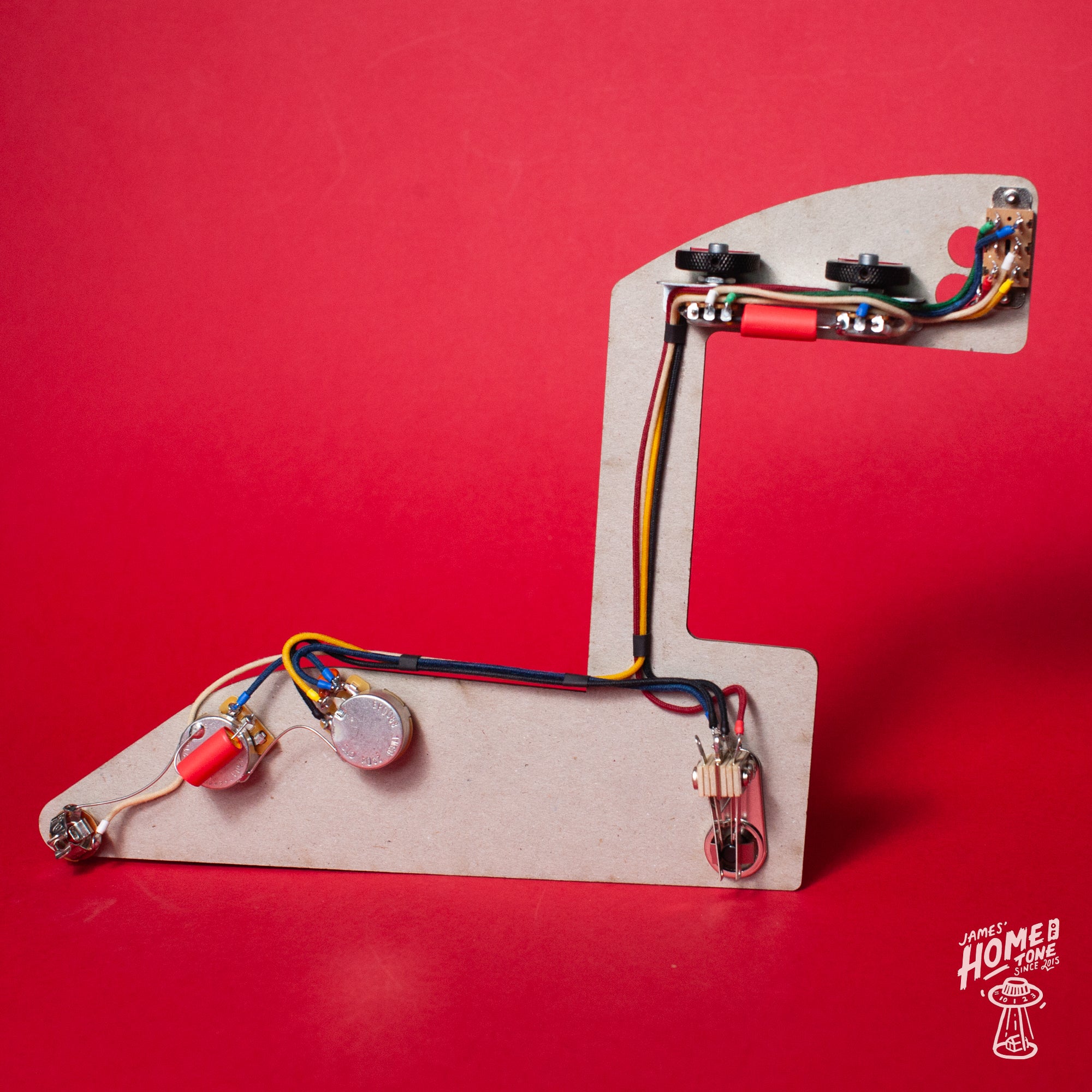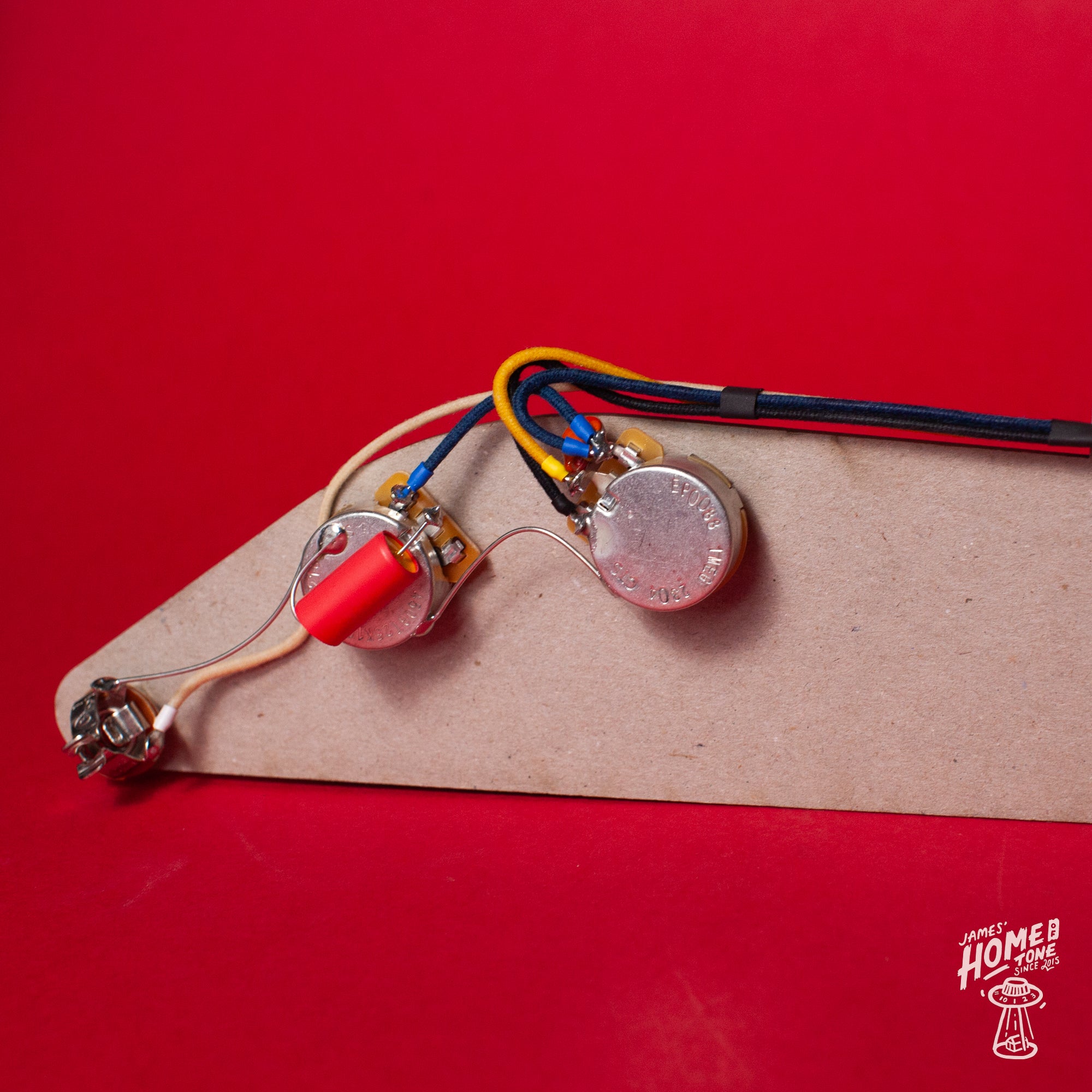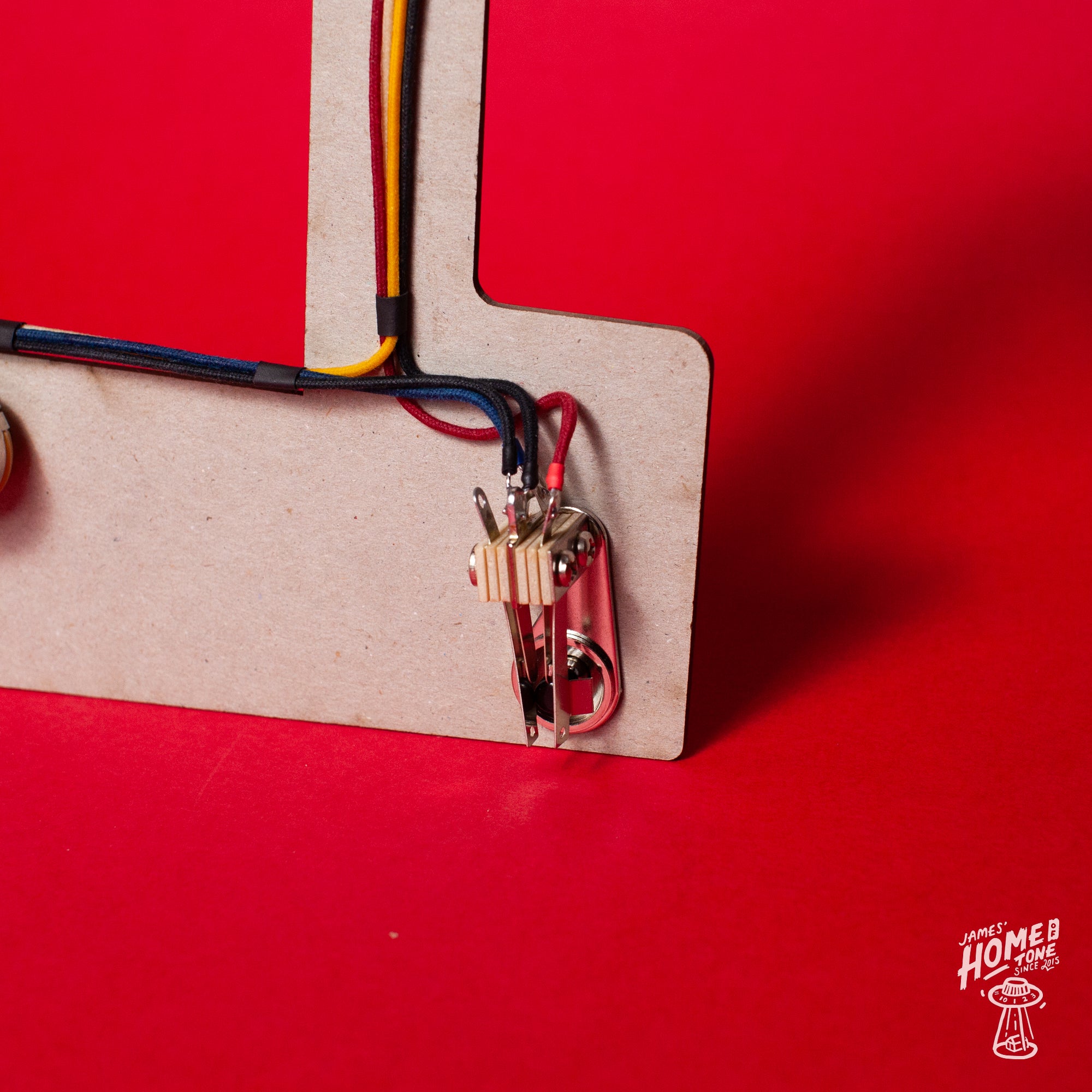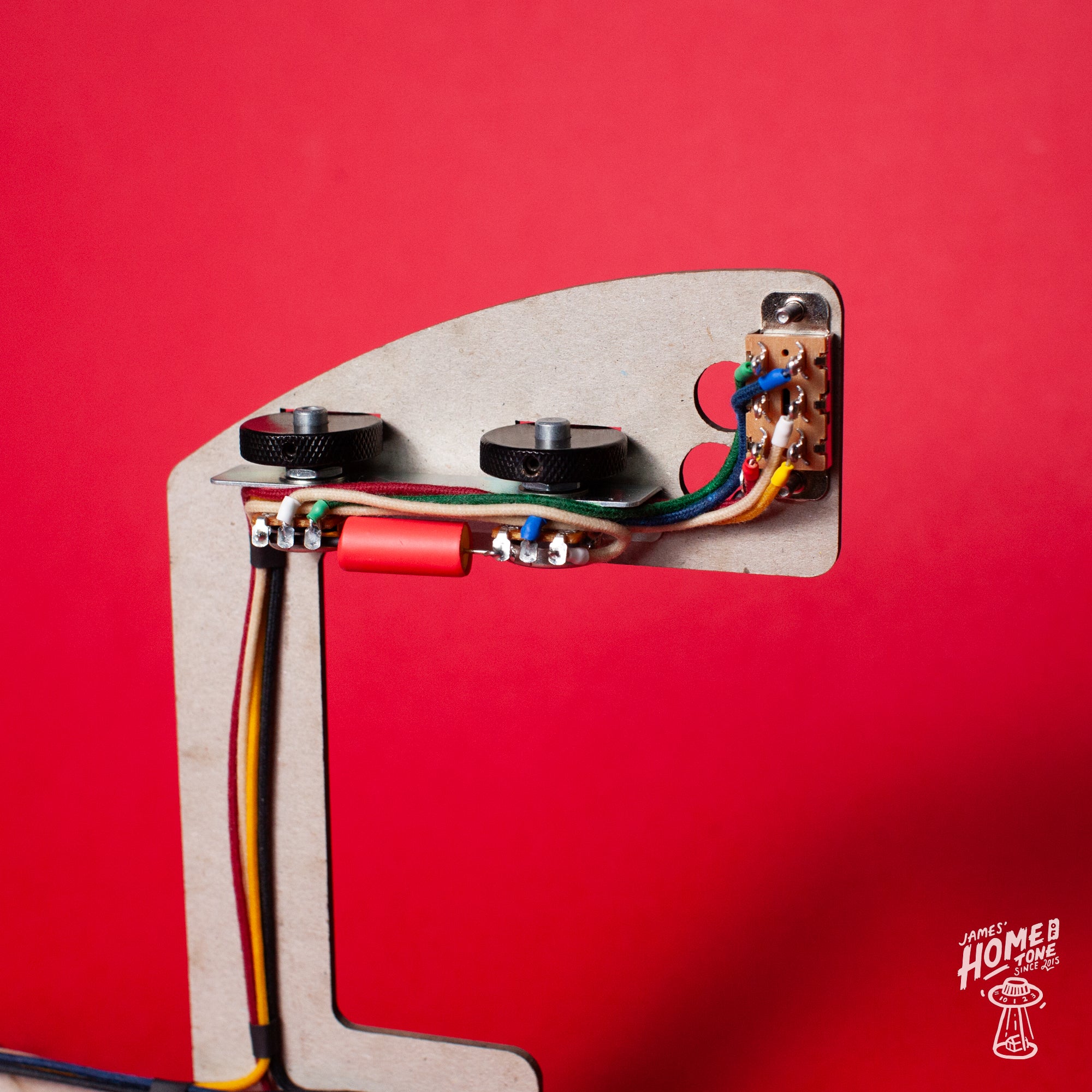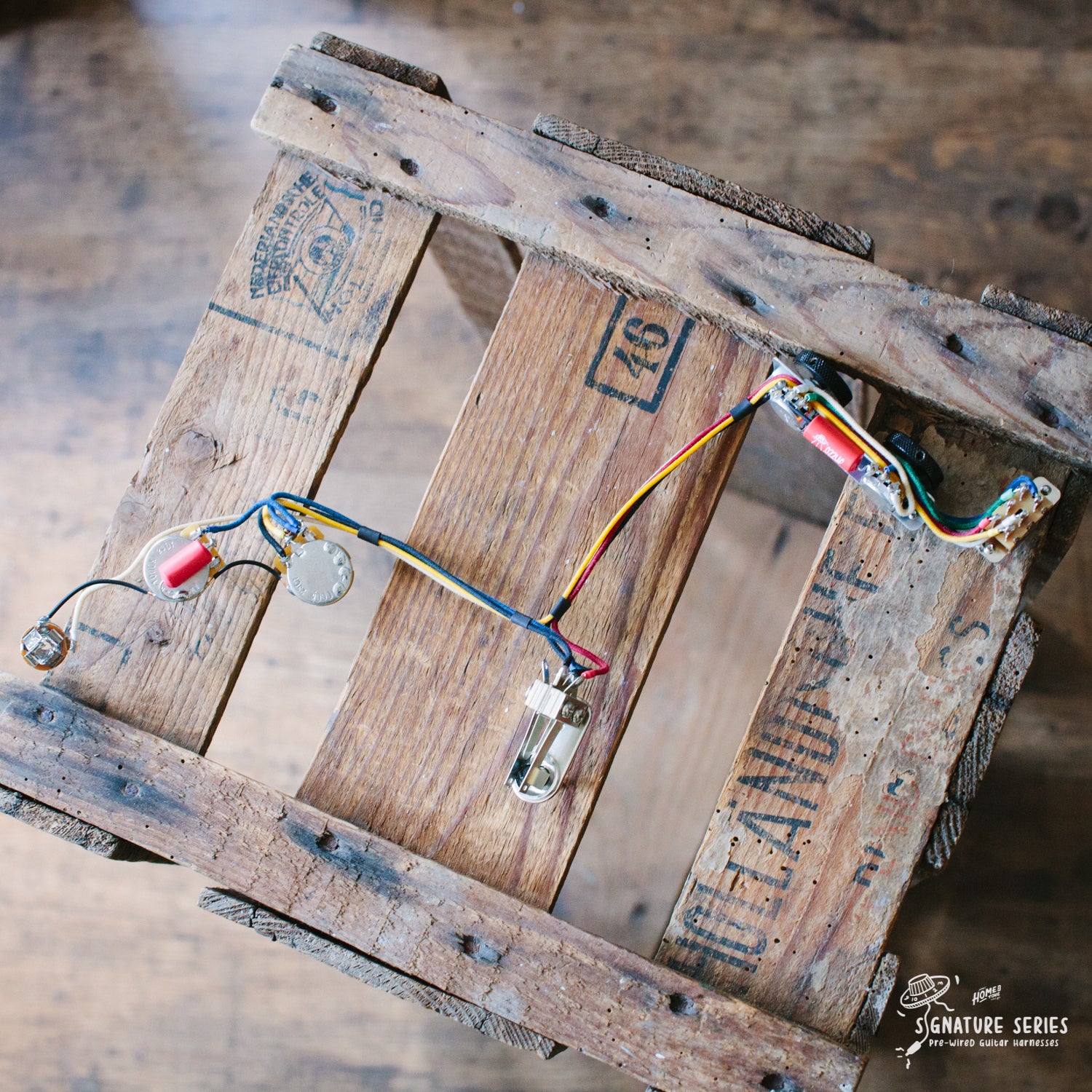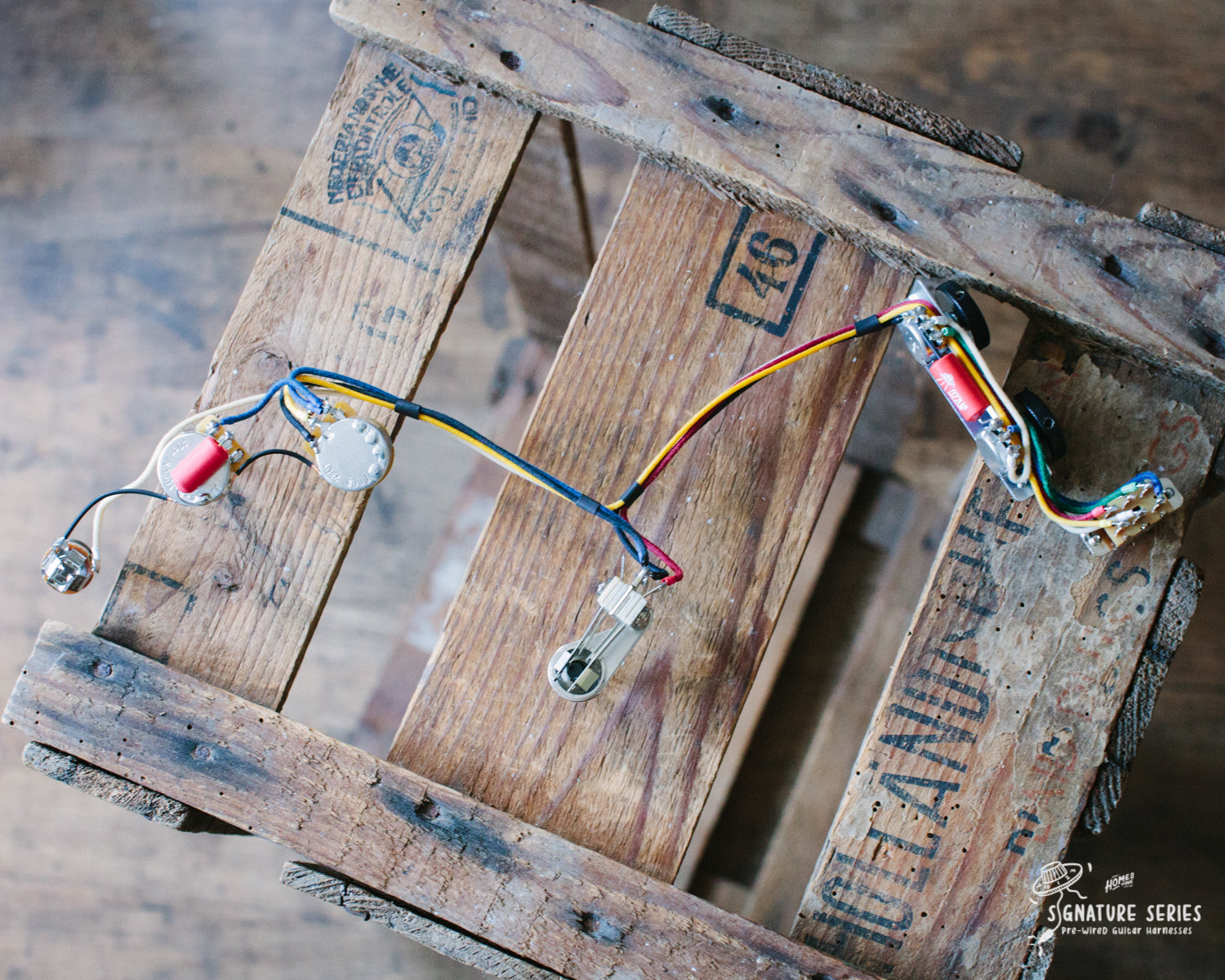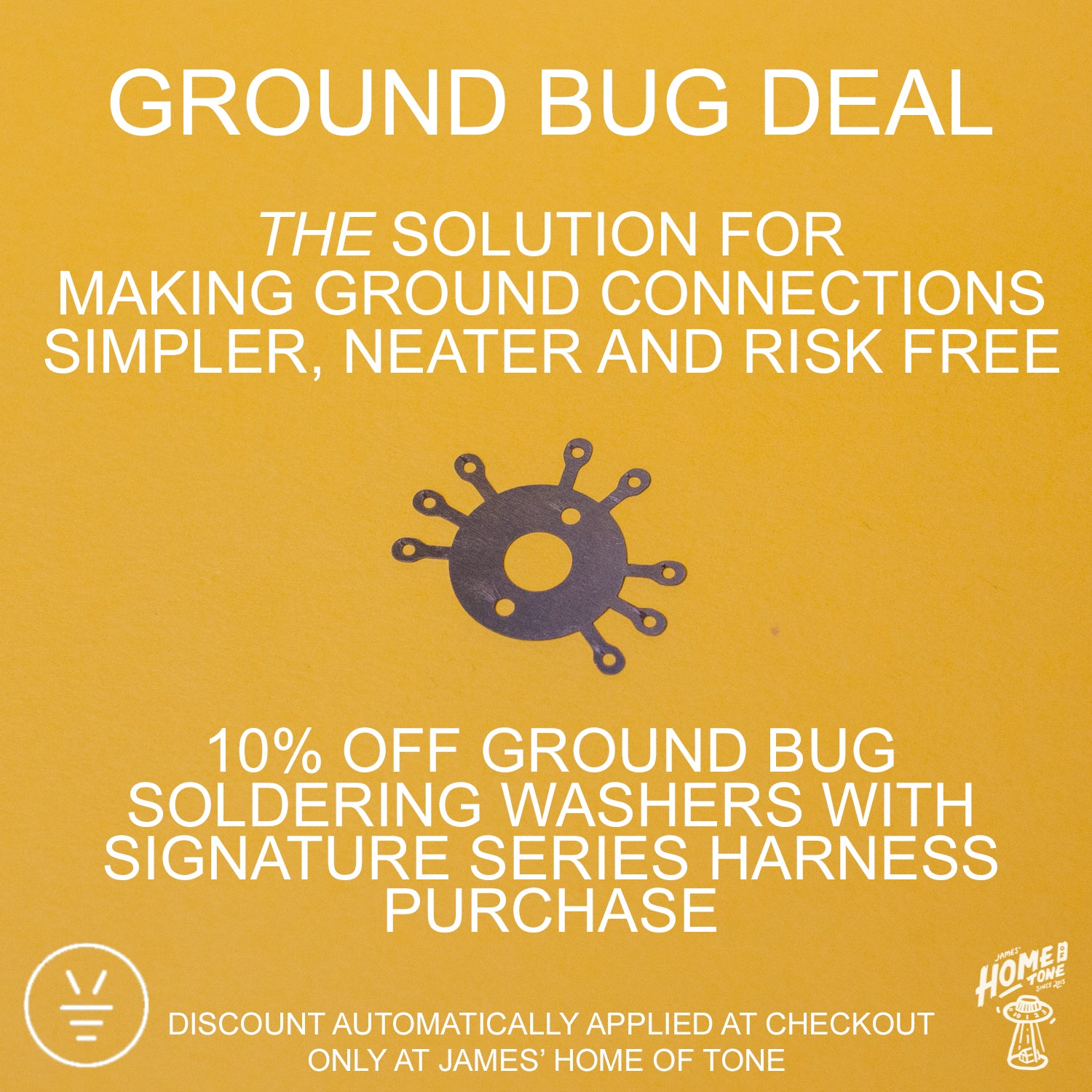Pre-Wired Guitar wiring harness | Full Jazzmaster kit | Left Handed
Order times
I usually make harnesses to order, due to the variety of spec options that could be chosen across the whole range. The current turnaround time for a Jazzmaster harness order is around 5-7 working days depending on quantity of orders in at the time and your order will be updated accordingly when it is dispatched. This turnaround time doesn't include the transit time. Thanks for your patience whilst I get your harness made!
Description
It's no secret that I love Jazzmasters. From the comfort of the offset body shape, to the intuitive vibrato and ultimately, the sound. So this harness was definitely driven by the passion I have for the Jazzmaster design!
This is the left handed orientation kit, there are some pot spec caveats that are worth noting though so please refer to the descriptions below in regards to pot turn directions and specs before ordering to ensure you choose the right kit to suit your needs.
Pot value options / pot turn direction
Unfortunately, choice is very limited for reverse/left handed audio taper pots. So if you prefer your pots to turn anti-clockwise from 0 to increase, that means you need reverse/left handed audio taper pots. For that spec I can only offer it in 250k and 500k lead circuit pot specs, as currently CTS aren't producing a 1MEG version.
If you prefer your pots to turn clockwise from 0 to increase, that means you need regular right handed audio taper pots. For that spec I can make the kit with 250k, 500k and 1MEG for you.
Not sure whether Left Handed/Reverse audio taper pots are 'right' for you? Check out this article I put together addressing the subject, and hopefully it will help you find the correct choice for your playing. HERE
Onto the pot spec choices and what that all means -
Traditionally, vintage (and some new vintage correct models) were supplied with 1MEG Linear taper volume pots in the lead circuit (whilst still having an audio taper pot in the tone position). So if you are looking for that real vintage spec, then this would be a good option.
I also offer it with the 'modern'-spec audio/logarithmic 1MEG lead circuit pots, this is perhaps the most popular choice for modern guitars as audio taper closer represents how the human ear responds to sound, in a logarithmic manner. But one thing I noticed with Jazzmasters is that due to their naturally bright tone, rolling off the 1MEG audio taper volume pot can naturally lose some of the brightness through the taper. So to help with this and retain the chime right through the pot sweep, I would perhaps recommend the option of a treble bleed cap too. This will help retain the otherwise 'lost' treble frequencies as the volume rolls down and puts it back into the signal helping maintain that JM chimey/bright character right down the volume pot. But as treble bleed caps aren't for everyone, it's available as an option with or without. Again, please note the 1MEG pot options are only available in the clockwise from 0 turn direction spec (RH pots).
If you have chosen a different set of pickups, like humbuckers or P90s perhaps, or simply want to tame some of the top end brightness associated with Jazzmasters, then I also offer this harness with 500k pots too! These are audio taper only and I can make this spec with LH or RH audio taper pots for you depending on personal preference.
It has become a popular choice recently to install much lower value 250k pots in the lead circuit also. I have decided to list it as an option now after some feedback from a good customer whom ordered it with this spec and loved the results. I can make this spec with LH or RH audio taper pots for you depending on personal preference.
I feel that this makes my traditional Jazzmaster wiring kit a great choice as you can choose the pot type and value/spec that suits your preferences, between vintage, modern, alternative pickup and personal tastes.
With or without Treble Bleed?
First up, what does it do? Without a 'treble bleed', when you roll down the volume pot it will naturally lose some of the treble frequencies through the sweep. Strat players in particular might be familiar with this as they are susceptible to it. So, A Treble Bleed kit takes the 'high' treble tone frequencies out of the circuit at the volume pot, and puts them back in the circuit as the signal leaves the volume pot. This means the treble frequencies are prevented from naturally bleeding out of the circuit as your turn your volume pot down. The result is a smoothed out treble and a more uniform tone from 1 to 10. Reducing the treble drop out as the volume pot rolls off. Some guitar players wouldn't be without a treble bleed, and many have never used one on their guitars. Truth is, it is very much personal preference. If you like the idea of retaining treble as you roll your volume pot down, then a treble bleed is for you! For the standard spec, I use a ceramic .001uF capacitor with a carbon film 120kOhm resistor parallel wired.
Cap value options
Similarly to the choices between pots, I also offer the choice of lead circuit tone capacitor value. Traditionally Jazzmasters with 1MEG lead circuit pots were paired with a .033uF tone capacitor. So if you're looking for traditional/vintage style specs, this may well be the choice for you and pairs very well with 1MEG pots.
But if you are perhaps going for 500k or 250k pots, then you may find a .033uF will soften the top end too much or create a less gradual tone pot sweep, so I also offer a .022uF cap value. Simply put, a .022uF will sound a little brighter than a .033uF cap and is a very popular pairing for 500k pots or 250k pots (as well as a popular choice for humbuckers or P90s for example if your JM has alternative pickup types).
Installing
I have intended for my wiring harnesses to be as simple as possible to install to your Jazzmaster, as well as writing in depth fitting guides, how-to instructions documenting the step by step process as well as a simple to follow wiring diagram.
It will be a 'drop-in' install for USA spec Jazzmasters, but for far Eastern build models, or alternative brand replica models then it may require modification. The parts I use, in particular the pots, are CTS branded pots which are imperial measurements. If you're fitting this harness to a far east built variant for example such as a Squier or similar, then you may have to widen the holes in the control plate to accommodate for these imperial measurement pots. Or alternatively, purchase a new control plate that is already suited to the US spec components.
For reference, the CTS pots I use in this harness have a shaft diameter of 9.52mm.
You may also require new control knobs to fit the CTS pot 'split shaft' spline diameter of 5.95mm with 24 splines (push fit style control knobs).
If you do require a US spec control plate or control knobs, we do carry a selection of popular options in stock and they can be viewed in the hardware & plastic hardware categories on the store.
The template board I make my harnesses on, was taken from measurements of a USA built Fender Jazzmaster. So here are some of the main centre to centre measurements between components to help ensure a good fit into your Jazzmaster. I do allow for some give in the wire lengths though to help with a comfortable fit -
Rhythm circuit slide switch (centre) to centre of rhythm circuit volume pot wheel - 40mm
Centre to centre of rhythm circuit pot wheels - 45mm
Centre to centre of rhythm circuit bracket mounting screws - 67mm
(Wire routing follows standard Jazzmaster body cavities from rhythm circuit to lead circuit section)
Centre of 3 way toggle switch to master volume pot - 11.5cm
Centre of master volume pot to master tone pot - 5.2cm
Centre of master tone pot to jack socket - 6cm
Specs
- Choice of lead circuit pot values/specs:
CTS 450 Series 1MEG RH Audio taper (volume and tone)
CTS 1MEG Linear taper for Volume (with RH audio taper for tone)
CTS '450' Series 500k audio taper (Volume and tone) LH or RH Audio taper available
CTS '450' Series 250k audio taper (volume and tone) LH or RH Audio taper available
- SoZo .033uF Mustard tone capacitor in the lead circuit (or choice of .022uF value)
- .022uF 'Yellow Mustard' type tone capacitor in the rhythm circuit
- Gavitt USA made multi coloured cloth covered 22AWG wire
- 20AWG Tinned copper ground
- Switchcraft right angle 3 way toggle switch
- Switchcraft on/on slide switch
- Right angle rhythm circuit mounting bracket
- 2x Roller wheel control knobs for ryhytm circuit
- 1x Alpha 1MEG mini pot
- 1x Alpha 50k mini pot
- Pure Tone multi contact jack socket
- Soldered using R-Tech Premium Lead-Free (Sn95.5Ag3.9Cu0.6) 22swg Solder wire
RoHS Compliant
RoHS Compliant components are used throughout pre-wired assemblies. All components used in this assembly are being used for their intended purposes stated in the guidelines by their relevant manufacturer. Any use outside of stated or recommended guidelines is entirely up to the customer, but sales support/warranty/refunds are then extinguished. For a run down of the manufacturers and product data sheets you can click HERE
Please note - wiring kit does not include new control knobs/switch tip/control plate etc but does include the pot/jack mounting nuts and washers and switch mounting screws/nut.
Why these spec parts over others available?
Simply put, component choice has been one of the most important parts of my product development. I have worked on guitars for many years, and built these kits professionally since 2015, and as a result have been able to see and experience working on the majority of components available on the market. In my findings, A/B testing and more, I have found the components I decided on for my Signature Series to be the most reliable, best tolerance and great functioning parts to use to help customers get the most out of their instruments. I use CTS '450' series premium spec pots as they have a tight tolerance, and will consistently provide me with accurate value, as well as very solid build quality. I use trusty 'Mustard' style polyester film 'tone' capacitors as in my opinion they simply can't be beat for great value, solid construction, solid lead-outs, super tight tolerances and reliable tone/function. I would personally much rather use a trusty Mustard for example over something like a paper in oil, as from experience that are so much more reliable to use. This is from carrying out a lot of A/B testing, both tonally, as well as armed with the multi-meter for testing values and actual tolerances, as well as handling them to test construction quality for long lasting reliability in use. I use the brilliant 'Pure Tone' Multi Contact Jack sockets as they are incredibly reliable, due to their additional contact points for both tip and sleeve. I use CRL, Oak and Switchcraft brand switches across the range as these are built very well, with care will last for many years to come and have long since provided me with reliable use professionally. All kits are wired up with quality USA made Gavitt wire, it's great to work with, super consistent gauge and provides me with a very reliable quality item for my kits. I totally understand that with anything guitar, it is subjective, but I have, with an open mind, thoroughly tested a broad variety of components over the years and these have all become the items I trust to use every day.
Harness FAQ's
I've been proudly making, developing and installing my pre-wired guitar harnesses since the beginning of the Home of Tone back in 2015 (time flies when you're having fun right!). Although I feel I do my best in covering as much information as possible across the various product listings, fitting guides, wiring diagrams and more, I thought it might be helpful to put together an FAQ's page that covers some of the general additional questions I get asked. You can view these Harness FAQ's HERE
'Ground Bug' deal!
Looking forward to installing your new wiring, but a little worried about making the ground connections to the pot casings? First time soldering and hear the horror stories of frying pots, or just simply want to neaten up your installs? Then the awesome 'Ground Bug' will help with any of these concerns, beginner or pro modders alike. The Ground Bug is a pot washer that fits between the pot casing and the pickguard/body and has a number of lugs (much like with the main signal connections on the pot for example) to which you can very easily solder your ground wire connections too. Completely removing the worry and risk of soldering a pot casing, something I know many guitarists complain about having to learn to do.
I have been stocking Ground Bugs for a while, and they really are the perfect match for a pre-wired harness as they further help you with your installs. So I have set up a 10% off Ground Bug deals when purchased with a Home of Tone Signature Series pre-wired harness. This is an automatic discount code, so all you need to have is a Signature Series kit, and a Ground bug in your cart, and the discount will automatically be applied to the bug for you! Click HERE to view the Ground Bug listing
Do you make custom harnesses?
I'm afraid I do not offer a custom harness service. Only kits developed, tested and listed on my website are the available kits. So no custom schematics etc. If you happen to be local to my office, then I do carry out custom work in house, but in regards to shipped out pre-wired harnesses I do not offer custom kits. I am however happy to use different pot values or cap values within reason if you have a specific requirement that differs to the specs listed above. If this is relevant to yourself then please get in touch to discuss further to ensure the request is possible.
GPSR & Safety info
Manufacturer: James' Home of Tone, Laburnum Street, Stourbridge, DY8 4NX, UK.
Email: james@homeoftone.co.uk
EU Authorised Representative: Global Trade Department (NI) Ltd, Office 834, Unit 6, 100 Lisburn Road, Belfast, BT9 6AG, Northern Ireland. Email: contact@globaltradedept.com
Intended user: The Signature Series pre-wired electric guitar and electric bass guitar harnesses are only intended to be used by an adult (over the age of 18). By a guitar repair professional, or someone with sufficient repair/modification experience.
Intended use: The Signature Series pre-wired electric guitar and electric bass guitar harness is a replacement and/or upgraded pre-wired harness kit that you can use to replace, retrofit or upgrade the volume, tone and pickup selection controls in an electric guitar or electric bass guitar. The Signature Series pre-wired electric guitar and electric bass guitar harness kit offers a quality, pre-assembled harness solution for your electric guitar or electric bass guitar model. Your existing guitar pickups can be installed to this pre-wired harness kit, to allow a factory equivalent or alternative control layout for your electric guitar or electric bass guitar as desired.
Full installation guidance can be found on each specific kits product listing, with detailed fitting notes and requirements along with links to the specific wiring diagram. Before starting any install, the full guides must be read to ensure a safe install process throughout. James' Home of Tone cannot and will not be held liable for any injury or damage caused by incorrect methods, handling and techniques whilst installing a Signature Series pre-wired kit. Professional installation only recommended.
The Signature Series Pre-Wired electric guitar harness is intended to be used for:
▪ The specific model of guitar or bass that is detailed in the product description
▪ A like-for-like replacement or upgrade retrofit for your guitar or basses existing volume, tone and pickup selection controls
▪ Adjusting the pickup selection, volume and tone where applicable on an amplified electric guitar during use
The Signature Series Pre-Wired electric guitar harness is not intended to be used:
▪ In a guitar or bass model that it is not specifically designed and advertised for
▪ where modifications to the kit, its schematic or its components are carried out
Order times
I usually make harnesses to order, due to the variety of spec options that could be chosen across the whole range. The current turnaround time for a Jazzmaster harness order is around 5-7 working days depending on quantity of orders in at the time and your order will be updated accordingly when it is dispatched. This turnaround time doesn't include the transit time. Thanks for your patience whilst I get your harness made!
Description
It's no secret that I love Jazzmasters. From the comfort of the offset body shape, to the intuitive vibrato and ultimately, the sound. So this harness was definitely driven by the passion I have for the Jazzmaster design!
This is the left handed orientation kit, there are some pot spec caveats that are worth noting though so please refer to the descriptions below in regards to pot turn directions and specs before ordering to ensure you choose the right kit to suit your needs.
Pot value options / pot turn direction
Unfortunately, choice is very limited for reverse/left handed audio taper pots. So if you prefer your pots to turn anti-clockwise from 0 to increase, that means you need reverse/left handed audio taper pots. For that spec I can only offer it in 250k and 500k lead circuit pot specs, as currently CTS aren't producing a 1MEG version.
If you prefer your pots to turn clockwise from 0 to increase, that means you need regular right handed audio taper pots. For that spec I can make the kit with 250k, 500k and 1MEG for you.
Not sure whether Left Handed/Reverse audio taper pots are 'right' for you? Check out this article I put together addressing the subject, and hopefully it will help you find the correct choice for your playing. HERE
Onto the pot spec choices and what that all means -
Traditionally, vintage (and some new vintage correct models) were supplied with 1MEG Linear taper volume pots in the lead circuit (whilst still having an audio taper pot in the tone position). So if you are looking for that real vintage spec, then this would be a good option.
I also offer it with the 'modern'-spec audio/logarithmic 1MEG lead circuit pots, this is perhaps the most popular choice for modern guitars as audio taper closer represents how the human ear responds to sound, in a logarithmic manner. But one thing I noticed with Jazzmasters is that due to their naturally bright tone, rolling off the 1MEG audio taper volume pot can naturally lose some of the brightness through the taper. So to help with this and retain the chime right through the pot sweep, I would perhaps recommend the option of a treble bleed cap too. This will help retain the otherwise 'lost' treble frequencies as the volume rolls down and puts it back into the signal helping maintain that JM chimey/bright character right down the volume pot. But as treble bleed caps aren't for everyone, it's available as an option with or without. Again, please note the 1MEG pot options are only available in the clockwise from 0 turn direction spec (RH pots).
If you have chosen a different set of pickups, like humbuckers or P90s perhaps, or simply want to tame some of the top end brightness associated with Jazzmasters, then I also offer this harness with 500k pots too! These are audio taper only and I can make this spec with LH or RH audio taper pots for you depending on personal preference.
It has become a popular choice recently to install much lower value 250k pots in the lead circuit also. I have decided to list it as an option now after some feedback from a good customer whom ordered it with this spec and loved the results. I can make this spec with LH or RH audio taper pots for you depending on personal preference.
I feel that this makes my traditional Jazzmaster wiring kit a great choice as you can choose the pot type and value/spec that suits your preferences, between vintage, modern, alternative pickup and personal tastes.
With or without Treble Bleed?
First up, what does it do? Without a 'treble bleed', when you roll down the volume pot it will naturally lose some of the treble frequencies through the sweep. Strat players in particular might be familiar with this as they are susceptible to it. So, A Treble Bleed kit takes the 'high' treble tone frequencies out of the circuit at the volume pot, and puts them back in the circuit as the signal leaves the volume pot. This means the treble frequencies are prevented from naturally bleeding out of the circuit as your turn your volume pot down. The result is a smoothed out treble and a more uniform tone from 1 to 10. Reducing the treble drop out as the volume pot rolls off. Some guitar players wouldn't be without a treble bleed, and many have never used one on their guitars. Truth is, it is very much personal preference. If you like the idea of retaining treble as you roll your volume pot down, then a treble bleed is for you! For the standard spec, I use a ceramic .001uF capacitor with a carbon film 120kOhm resistor parallel wired.
Cap value options
Similarly to the choices between pots, I also offer the choice of lead circuit tone capacitor value. Traditionally Jazzmasters with 1MEG lead circuit pots were paired with a .033uF tone capacitor. So if you're looking for traditional/vintage style specs, this may well be the choice for you and pairs very well with 1MEG pots.
But if you are perhaps going for 500k or 250k pots, then you may find a .033uF will soften the top end too much or create a less gradual tone pot sweep, so I also offer a .022uF cap value. Simply put, a .022uF will sound a little brighter than a .033uF cap and is a very popular pairing for 500k pots or 250k pots (as well as a popular choice for humbuckers or P90s for example if your JM has alternative pickup types).
Installing
I have intended for my wiring harnesses to be as simple as possible to install to your Jazzmaster, as well as writing in depth fitting guides, how-to instructions documenting the step by step process as well as a simple to follow wiring diagram.
It will be a 'drop-in' install for USA spec Jazzmasters, but for far Eastern build models, or alternative brand replica models then it may require modification. The parts I use, in particular the pots, are CTS branded pots which are imperial measurements. If you're fitting this harness to a far east built variant for example such as a Squier or similar, then you may have to widen the holes in the control plate to accommodate for these imperial measurement pots. Or alternatively, purchase a new control plate that is already suited to the US spec components.
For reference, the CTS pots I use in this harness have a shaft diameter of 9.52mm.
You may also require new control knobs to fit the CTS pot 'split shaft' spline diameter of 5.95mm with 24 splines (push fit style control knobs).
If you do require a US spec control plate or control knobs, we do carry a selection of popular options in stock and they can be viewed in the hardware & plastic hardware categories on the store.
The template board I make my harnesses on, was taken from measurements of a USA built Fender Jazzmaster. So here are some of the main centre to centre measurements between components to help ensure a good fit into your Jazzmaster. I do allow for some give in the wire lengths though to help with a comfortable fit -
Rhythm circuit slide switch (centre) to centre of rhythm circuit volume pot wheel - 40mm
Centre to centre of rhythm circuit pot wheels - 45mm
Centre to centre of rhythm circuit bracket mounting screws - 67mm
(Wire routing follows standard Jazzmaster body cavities from rhythm circuit to lead circuit section)
Centre of 3 way toggle switch to master volume pot - 11.5cm
Centre of master volume pot to master tone pot - 5.2cm
Centre of master tone pot to jack socket - 6cm
Specs
- Choice of lead circuit pot values/specs:
CTS 450 Series 1MEG RH Audio taper (volume and tone)
CTS 1MEG Linear taper for Volume (with RH audio taper for tone)
CTS '450' Series 500k audio taper (Volume and tone) LH or RH Audio taper available
CTS '450' Series 250k audio taper (volume and tone) LH or RH Audio taper available
- SoZo .033uF Mustard tone capacitor in the lead circuit (or choice of .022uF value)
- .022uF 'Yellow Mustard' type tone capacitor in the rhythm circuit
- Gavitt USA made multi coloured cloth covered 22AWG wire
- 20AWG Tinned copper ground
- Switchcraft right angle 3 way toggle switch
- Switchcraft on/on slide switch
- Right angle rhythm circuit mounting bracket
- 2x Roller wheel control knobs for ryhytm circuit
- 1x Alpha 1MEG mini pot
- 1x Alpha 50k mini pot
- Pure Tone multi contact jack socket
- Soldered using R-Tech Premium Lead-Free (Sn95.5Ag3.9Cu0.6) 22swg Solder wire
RoHS Compliant
RoHS Compliant components are used throughout pre-wired assemblies. All components used in this assembly are being used for their intended purposes stated in the guidelines by their relevant manufacturer. Any use outside of stated or recommended guidelines is entirely up to the customer, but sales support/warranty/refunds are then extinguished. For a run down of the manufacturers and product data sheets you can click HERE
Please note - wiring kit does not include new control knobs/switch tip/control plate etc but does include the pot/jack mounting nuts and washers and switch mounting screws/nut.
Why these spec parts over others available?
Simply put, component choice has been one of the most important parts of my product development. I have worked on guitars for many years, and built these kits professionally since 2015, and as a result have been able to see and experience working on the majority of components available on the market. In my findings, A/B testing and more, I have found the components I decided on for my Signature Series to be the most reliable, best tolerance and great functioning parts to use to help customers get the most out of their instruments. I use CTS '450' series premium spec pots as they have a tight tolerance, and will consistently provide me with accurate value, as well as very solid build quality. I use trusty 'Mustard' style polyester film 'tone' capacitors as in my opinion they simply can't be beat for great value, solid construction, solid lead-outs, super tight tolerances and reliable tone/function. I would personally much rather use a trusty Mustard for example over something like a paper in oil, as from experience that are so much more reliable to use. This is from carrying out a lot of A/B testing, both tonally, as well as armed with the multi-meter for testing values and actual tolerances, as well as handling them to test construction quality for long lasting reliability in use. I use the brilliant 'Pure Tone' Multi Contact Jack sockets as they are incredibly reliable, due to their additional contact points for both tip and sleeve. I use CRL, Oak and Switchcraft brand switches across the range as these are built very well, with care will last for many years to come and have long since provided me with reliable use professionally. All kits are wired up with quality USA made Gavitt wire, it's great to work with, super consistent gauge and provides me with a very reliable quality item for my kits. I totally understand that with anything guitar, it is subjective, but I have, with an open mind, thoroughly tested a broad variety of components over the years and these have all become the items I trust to use every day.
Harness FAQ's
I've been proudly making, developing and installing my pre-wired guitar harnesses since the beginning of the Home of Tone back in 2015 (time flies when you're having fun right!). Although I feel I do my best in covering as much information as possible across the various product listings, fitting guides, wiring diagrams and more, I thought it might be helpful to put together an FAQ's page that covers some of the general additional questions I get asked. You can view these Harness FAQ's HERE
'Ground Bug' deal!
Looking forward to installing your new wiring, but a little worried about making the ground connections to the pot casings? First time soldering and hear the horror stories of frying pots, or just simply want to neaten up your installs? Then the awesome 'Ground Bug' will help with any of these concerns, beginner or pro modders alike. The Ground Bug is a pot washer that fits between the pot casing and the pickguard/body and has a number of lugs (much like with the main signal connections on the pot for example) to which you can very easily solder your ground wire connections too. Completely removing the worry and risk of soldering a pot casing, something I know many guitarists complain about having to learn to do.
I have been stocking Ground Bugs for a while, and they really are the perfect match for a pre-wired harness as they further help you with your installs. So I have set up a 10% off Ground Bug deals when purchased with a Home of Tone Signature Series pre-wired harness. This is an automatic discount code, so all you need to have is a Signature Series kit, and a Ground bug in your cart, and the discount will automatically be applied to the bug for you! Click HERE to view the Ground Bug listing
Do you make custom harnesses?
I'm afraid I do not offer a custom harness service. Only kits developed, tested and listed on my website are the available kits. So no custom schematics etc. If you happen to be local to my office, then I do carry out custom work in house, but in regards to shipped out pre-wired harnesses I do not offer custom kits. I am however happy to use different pot values or cap values within reason if you have a specific requirement that differs to the specs listed above. If this is relevant to yourself then please get in touch to discuss further to ensure the request is possible.
GPSR & Safety info
Manufacturer: James' Home of Tone, Laburnum Street, Stourbridge, DY8 4NX, UK.
Email: james@homeoftone.co.uk
EU Authorised Representative: Global Trade Department (NI) Ltd, Office 834, Unit 6, 100 Lisburn Road, Belfast, BT9 6AG, Northern Ireland. Email: contact@globaltradedept.com
Intended user: The Signature Series pre-wired electric guitar and electric bass guitar harnesses are only intended to be used by an adult (over the age of 18). By a guitar repair professional, or someone with sufficient repair/modification experience.
Intended use: The Signature Series pre-wired electric guitar and electric bass guitar harness is a replacement and/or upgraded pre-wired harness kit that you can use to replace, retrofit or upgrade the volume, tone and pickup selection controls in an electric guitar or electric bass guitar. The Signature Series pre-wired electric guitar and electric bass guitar harness kit offers a quality, pre-assembled harness solution for your electric guitar or electric bass guitar model. Your existing guitar pickups can be installed to this pre-wired harness kit, to allow a factory equivalent or alternative control layout for your electric guitar or electric bass guitar as desired.
Full installation guidance can be found on each specific kits product listing, with detailed fitting notes and requirements along with links to the specific wiring diagram. Before starting any install, the full guides must be read to ensure a safe install process throughout. James' Home of Tone cannot and will not be held liable for any injury or damage caused by incorrect methods, handling and techniques whilst installing a Signature Series pre-wired kit. Professional installation only recommended.
The Signature Series Pre-Wired electric guitar harness is intended to be used for:
▪ The specific model of guitar or bass that is detailed in the product description
▪ A like-for-like replacement or upgrade retrofit for your guitar or basses existing volume, tone and pickup selection controls
▪ Adjusting the pickup selection, volume and tone where applicable on an amplified electric guitar during use
The Signature Series Pre-Wired electric guitar harness is not intended to be used:
▪ In a guitar or bass model that it is not specifically designed and advertised for
▪ where modifications to the kit, its schematic or its components are carried out

